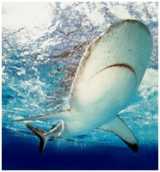 |
Sharks
Sharks have been around for about 350 million years and have remained virtually unchanged for the past 70 million years and still comprise a dominant group. They live in waters all over the world, in every ocean, and even in some rivers and lakes.
Unlike bony fish, sharks have no bones; their skeleton is made of cartilage, which is a tough, fibrous substance, not nearly as hard as bone. Sharks also have no swim bladder (like bony fish do).
|
Enchanted Learning - All about sharks!
http://www.enchantedlearning.com/subjects/sharks/
This is an ideal place to start with a comprehensive site designed for students:
Major areas covered are: Anatomy and Physiology, Shark Info Sheets, Shark Printouts, Megalodon: Ancient Giant, Rays, Shark Dictionary, Shark Pop-up card.
The Anatomy and Physiology section includes: size, body shapes, varieties of sharks, skeleton, teeth, diet, do sharks sleep?, shark feeding frenzyattacks, intelligence, habitat, migration, evolution,and extinct sharks. There are also information sheets on over 30 species of shark.
How Sharks Work
http://www.howstuffworks.com/shark1.htm
From the HowStuffWorks site. An exellent introduction including, Shark Anatomy, Underwater, Basic Shark Senses, Extra Shark Senses, Shark Teeth, Daily Life of a Shark, Threats to Sharks, Lots More Information!, What do you think?
Seaworld Education Department Resource:
Sharks & Rays
http://www.seaworld.org/infobooks/Sharks&Rays/home.html
Another site with a wealth of information on sharks. Major topics covered are: Scientific Classification, Habitat and Distribution, Physical Characteristics, Senses, Behaviour, Diet and Eating Habits, Reproduction, Anatomy and Physiology, Hydrodynamics,
Longevity and Causes of Death, Classification, Bibliography,
Books for Young Readers

Tiger shark jaws
|